Custom Wallet Manager
Posted: 2011-01-21 Filed under: market | Tags: industry, trade 23 CommentsA few months ago, a corp mate and I started trading and we needed a centralized method of monitoring our activity. We tried a few programs such as eve commander, but we wanted more out of the system. My corp mate James has helped me design and code up a custom wallet manager.
James picked the framework, introduced me to the coding methodology, and wrote a lot of the database queries given his strong programming background. I helped out by defining what we should report on, what stats were the most valuable, and a little theme design.
What we have now is a pretty solid beta of our wallet program. We do not currently have any plans to publicly release the code, but things might change as we finalize the project.
Overview
ISK Movement – Income, taxes, and broker fees
API – Timer update stats for API feed
Characters – summary of wallets
Movers – top 30 items sorted by profit for the past month
Transactions
Shows where, to who, and how much for each item.
Item Report
See how each item is performing.
Stock Report
Custom defined groups (fuel, Battleships, etc)
Lists if you have any orders for that item including remaining / total of the original order
Volume that has sold over the past 30 days
Profit for that item over the past 30 days
Profit Report
1 day, 5 day, and 20 day averages
Sale and Volume Report

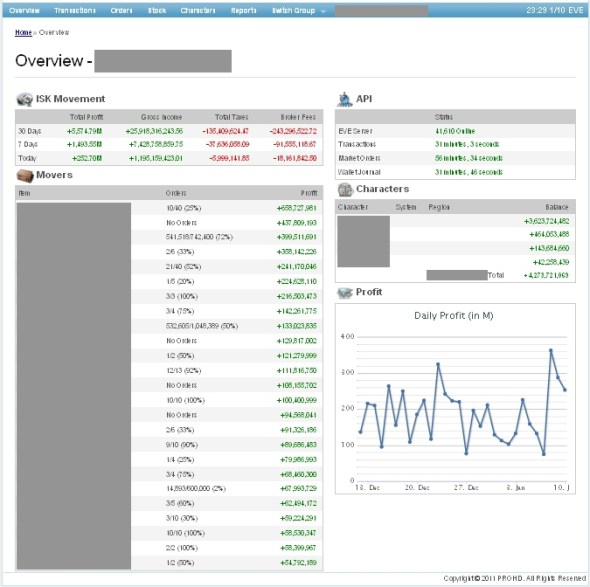
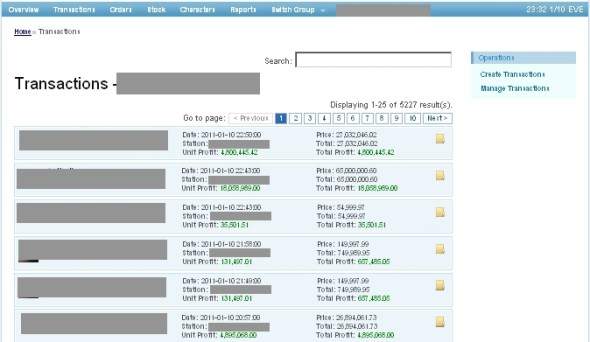
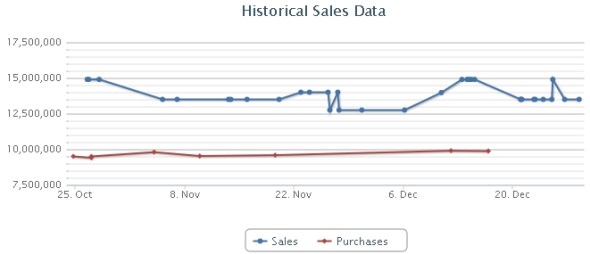
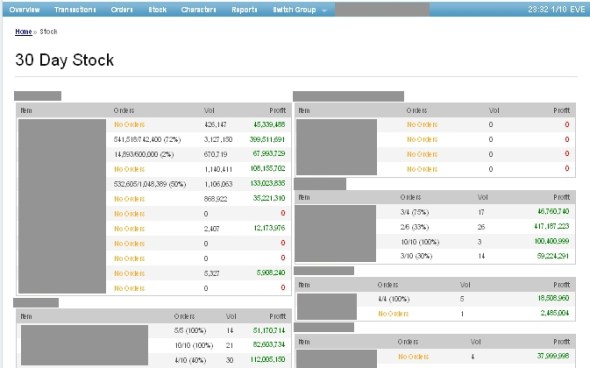
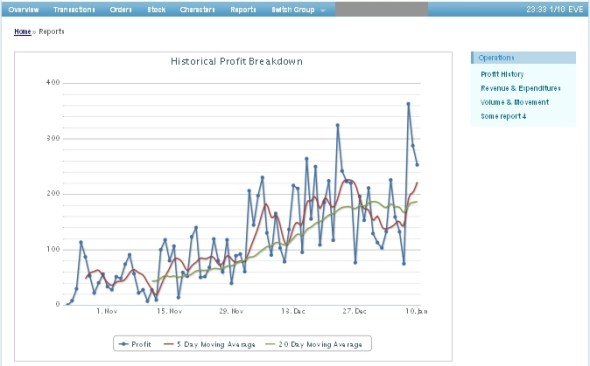
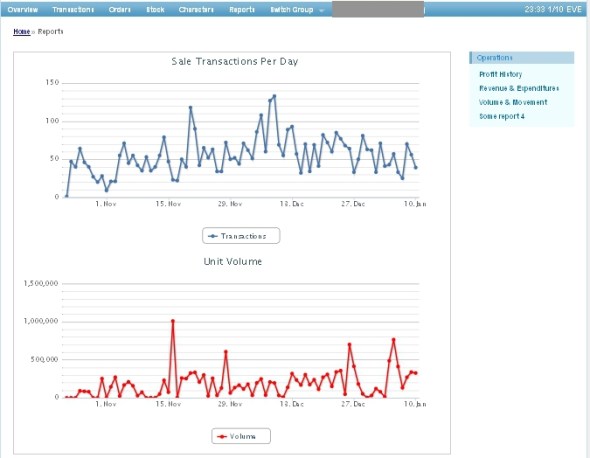
This looks very nice, is there any way for us to try it out?
Sadly, not at this time. The code is very custom and isn’t just a “copy my PHP to your www server and go” type of thing since it was build on the Yii framework. We’re still adding things to it so once it gets to a solid v1.0, we might release the source.
Ahh… I was thinking of doing something similar with Symfony. 😀 Good work!
This makes me want to cry. I want so bad 🙂
Yii looks nice. I guess Rails would be just as good, depending on your level of expertise with PHP or Ruby?
Where does the wallet API let you down, and what would you add to it if you could?
The wallet API is actually pretty nice. Whatever you can see in Eve, you can also grab via the API. Some things we don’t really track, as they don’t interest us much, and much of the journal api is just there to give us some gross income numbers and tax figures.
Yii has been quite nice, although with the caveat that the community around it is very young, and thus a lot of questions you may have may not have immediate answers in edge cases. The upside is that deployment and prototyping is extremely easy and rapid, and the documentation, while occasionally lacking in descriptiveness, is pretty thorough.
What the wallet API doesn’t do is track specific instances of items. So, it can be hard to say that this one specific Republic Fleet EMP round was sold at one specific place. You know when you buy things, and when you sell them, but the asset api really handles everything in between, and that’s something we haven’t really wanted to tackle as it offers us limited usefulness except perhaps in calculating net asset value. As long as you have consistent trade practices and routines, the data that comes out is very accurate. It probably would not be very good for traders that buy and sell all over the place. We buy in one station and sell in a very few handful of others, so keeping things together is very straightforward.
-James
Thanks James, yep I have the same issue with specific instances of items on my mega spreadsheets, but as you say if you’re in a routine you can kinda figure it out.
Do you get data from Eve Central? I’m working through the API at the moment and it looks pretty straightforward.
We don’t currently use Eve Central for pricing information. We calculate our profits from our actual purchase prices. Basically, when an item is sold, we look at the last time we purchased that item to get our profit margin. This can be slightly inaccurate in cases where you buy at two different prices in a close time frame and then sell that item, but we’ve found that over time these errors are pretty marginal. Additionally, we use jQuery Highcharts to generate a buy and sell historical graph for each item which gives us all the data points over time, thus giving us a pretty good idea as to how the prices are trending and what exactly our stock was purchased for and is selling for.
-James
I was looking for something similar and ended up using EVE Mentat. Their Alpha version is also pretty amazing!
Please release this when it’s done, it is exactly what I’m looking for!.
Blake,
You guys rock! You made a wonderful and very helpful market tool. I hope you can find a way to share it with the rest of us. *insert evil grin*
Fly safe,
Chebri
This would be useful to so many people! Good work!
Here’s hoping for a public release 🙂
Akinesis
Heya, loving the look and functionality.
I know you’re not ready to release the source code, I’m looking to get started on some api programming, and this looks fairly similar to the kind of tools I’d be interested in building, is there any chance I can have a neutered copy of the API extraction scripts you use? or at least a pointer towards which api’s you use to extract the data with?
Cheers
The API processing scripts are indeed custom built on top of the Yii framework, and operate more like data model classes. They would not be useful outside of our application.
That being said, the API is extremely easy to code for. As a PHP user myself, all that is required is cURL to grab the data from the URI (which is not strictly necessary, file_get_contents can suffice for basic stuff if you don’t care about specific error checking and timeouts), then I make it into a SimpleXML object for processing, as the API of course just returns plain XML data. Very trivial stuff really.
-James
Epic when can i get this!
Our point of sale software uses a similar technique to calculate profit, It calculates the moving average cost price,
the last purchase price, and if you want a set purchase price. and from there you can choose which one you want, the average cost price is probably much more accurate.
unless you do things like track purchase price and volume, and slowly weed out the oldest purchased stock first, from the average price. resulting in an average cost of stock on hand.
This how ever is rather complicated to do 😛
Does your API data get stashed in XML form, or marshalled into memory, or persisted to a database? Any thoughts/experiences in that regard? I’m working on a Rails app to do something similar, though with a focus on production chains.
o/
[…] Custom Wallet Manager and my trading operation has undergone some growth in the past two weeks as I have been expanding […]
[…] If you are not aware, my friend James and I have been working on a custom wallet manager. […]
[…] Refined Capital Production Page Custom Wallet Manager […]
[…] materials to end product, but come on. I’m an industrialist-spreadsheet-custom-sql-database-wallet-manager type of guy and have spent hours trying to figure out to optimize my Tier 2 production […]
[…] in September and October, I am back in the flow of the markets. Below are some screenshots from my Wallet Manager. Since I have added the ability to report on our historical prices, I have greater insight into the […]
[…] the Aura project. The fancy graphs and reporting logic that I have been able to generate out of my Wallet Manager site would be a wonderful addition to his suite (I hope to bring some of this design to the Eve […]
[…] Custom Wallet Manager […]